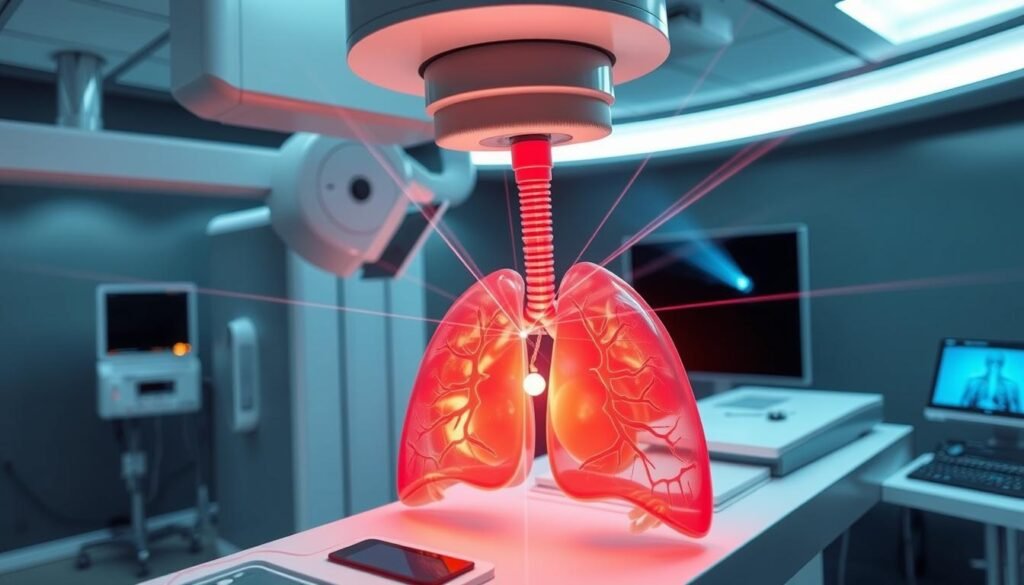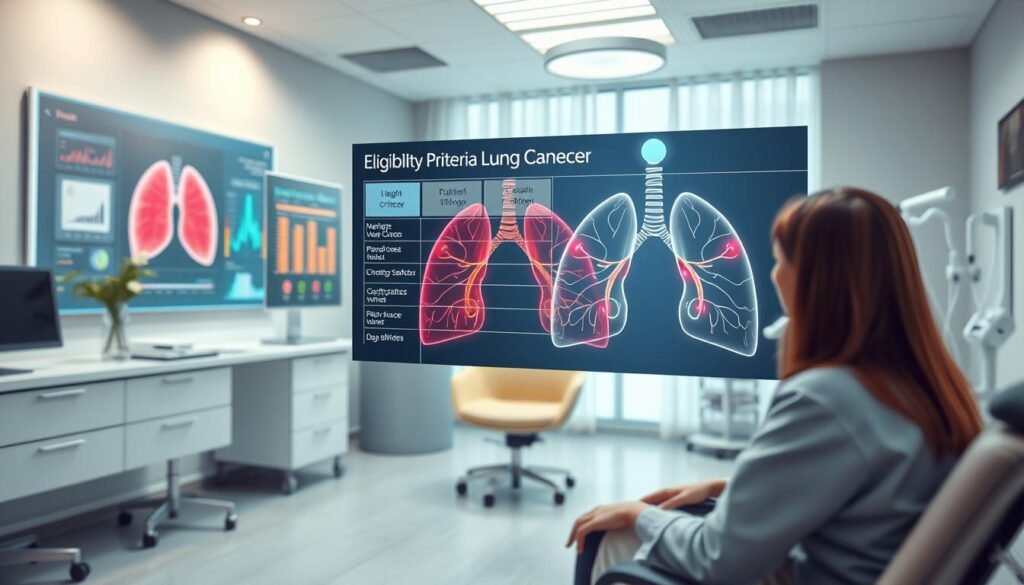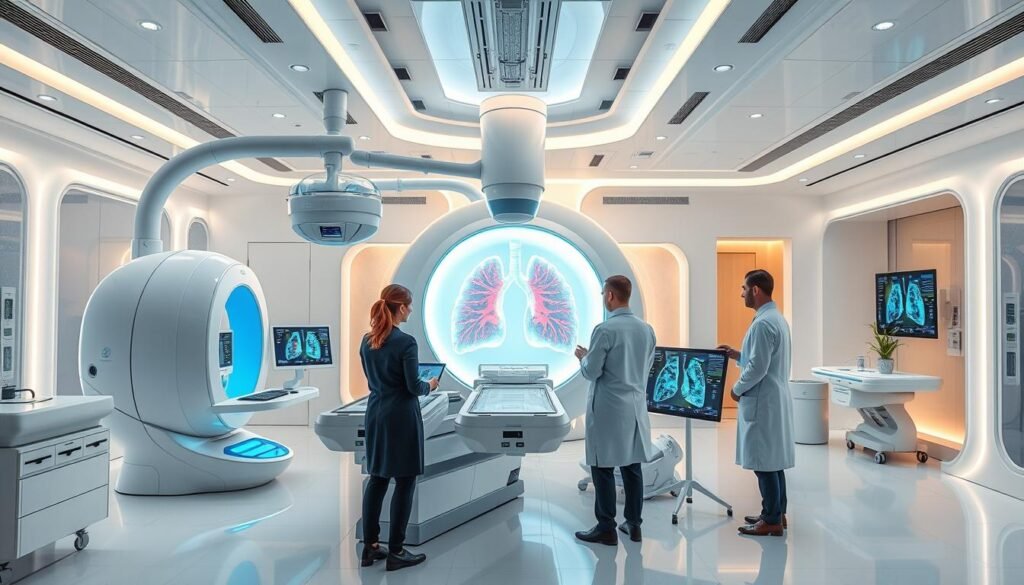About 85% of lung cancers are non-small cell lung cancer (NSCLC). This type is a top cause of cancer-related deaths. Sadly, only 17% are found early. More than half of people with NSCLC get radiotherapy. Many choose radiosurgery. This guide looks at high-tech radiotherapy, especially stereotactic body radiation therapy (SBRT). SBRT is great at targeting lung tumors.
This text explains how radiosurgery works. It’s a non-invasive way to fight cancer. We’ll check out its benefits and the latest tech. It’s important for patients and doctors to understand these new methods.
Key Takeaways
- Radiosurgery, particularly SBRT, is becoming a standard treatment for early-stage NSCLC.
- Precision targeting minimizes damage to surrounding healthy tissues.
- Many lung cancer patients benefit from radiotherapy, whether curative or palliative.
- Only a small percentage of lung cancers are diagnosed in the early stages, highlighting the need for advanced treatments.
- Research continues to evolve, leading to improved outcomes with radiosurgery.
Overview of Lung Cancer and Its Treatment Options
Lung cancer is a major health issue globally. It leads to many cancer cases each year. Non-small cell lung cancer (NSCLC) is the most common type, representing about 85% of cases. It’s important to know the treatment options to help patients.
Standard treatments include surgery, chemotherapy, and radiation. Surgery removes the tumor and nearby lymph nodes. Common procedures are lobectomy and pneumonectomy. For those who can’t have surgery, external beam radiation is crucial. Radiation uses high-energy beams to kill cancer cells. Treatments are painless and happen several times a week.
Lung cancer has a big impact. In 2014, the U.S. expected around 224,210 new cases and 159,260 deaths. It causes more deaths annually than all other cancers combined. This shows why effective treatments are vital.
For NSCLC, treatments depend on the cancer stage, which ranges from I to IV. The stage shows how much the cancer has spread. A plan might include different treatments and regular check-ups. This improves treatment success and patient survival.
New radiation methods like Stereotactic Body Radiation Therapy (SBRT) show promise. SBRT delivers focused, high-dose radiation. This lets doctors target tumors more accurately. You can learn more about lung cancer treatments here.
Understanding Radiosurgery as a Non-Invasive Treatment
Radiosurgery is a groundbreaking method in non-invasive lung cancer treatment. It does not require cutting into the body. Instead, it uses focused radiation beams to destroy tumors. This approach spares the healthy tissues around the tumor, showing its value in treating lung cancer.
This kind of targeted radiation therapy is perfect for those who can’t undergo surgery due to health issues. It helps people with early-stage lung cancer. They see good outcomes without the risks tied to standard surgeries.
Thanks to new technology like Linear Accelerator (LINAC) systems, radiosurgery has become easier to get. LINAC machines can tackle small tumors in one go or bigger ones across multiple sessions. This shows the adaptability in how treatment is planned.
For more details on stereotactic body radiation therapy, often used in radiosurgery, check out this informative page. The page explains how these treatments work and their role in fighting lung cancer.
Techniques like Gamma Knife and proton beam therapy offer a non-invasive choice. They also make recovery quicker. Most patients have few side effects, promising a strong option in lung cancer treatment.
What is Stereotactic Body Radiation Therapy (SBRT)?
Stereotactic body radiation therapy (SBRT) focuses on fighting lung cancer. It sends high-dose radiation right to the tumor, protecting healthy areas. Its precise technology targets only the cancer, making it a smart choice for treatment.
Mechanism of Action
SBRT works by aiming high-dose radiation at the tumor. It’s given in 1 to 5 sessions. This method can greatly affect tumors. It uses special machines to hit the target perfectly, using either standard rays or proton beams.
Advantages of SBRT in Lung Cancer Treatment
The benefits of SBRT for lung cancer are many:
- Minimally invasive: No surgery means fewer risks.
- Fewer hospital visits: Only a few sessions are needed.
- Shorter treatment durations: Treatment is much faster than old methods.
- High control rates: About 90% of patients see their tumor controlled after five years.
SBRT shows major progress in treating cancer. It helps patients live their lives while fighting the disease effectively.
Radiosurgery for Lung Cancer: How It Works
Radiosurgery in lung cancer is a big step forward, using high-tech ways for exact tumor targeting. It aims the radiation just right, keeping healthy tissues safe. Thanks to new developments, radiosurgery is now a top choice for many.
Precision Targeting of Lung Tumors
This treatment is known for its sharp aim. Doctors use modern imaging to find tumors, even hidden ones. This means patients get stronger radiation but in fewer visits. For example, SBRT can be done in just 1 to 8 sessions, cutting down the treatment time. Plus, it has a success rate of 95.7% in stopping the tumor from coming back within three years.
Comparison with Traditional Radiation Therapy
Compared to the old way, radiosurgery for lung cancer has clear benefits. Traditional therapy takes longer and might give unwanted radiation. But SBRT zeros in on the tumor with high doses. The survival rate for people getting radiosurgery is notable, at 78.2%. This shows better control over the tumor and hints at better chances for patients. Besides, the risk of bad side effects is very low, making it a safer choice.

Types of Radiosurgery Options: CyberKnife and Gamma Knife
Options like CyberKnife and Gamma Knife offer new ways to fight lung cancer. Each has special features for different needs and tumors. This means patients get treatments just right for them.
CyberKnife: Unique Features
CyberKnife is a big leap in fighting cancer without surgery. It uses a robot for precise radiation from many angles. This lets it tackle various tumors, including in the lungs.
Its standout feature is tracking tumors in real-time. This tracks patient movement, aiming radiation accurately. This leads to extreme precision, protecting healthy tissue from radiation.
Gamma Knife: Application in Lung Cancer
Gamma Knife is mainly for brain tumors but also works for lung cancer. It uses a special method, but needs a head frame for setup. This makes it less flexible than CyberKnife.
Gamma Knife patients might need anesthesia, unlike with CyberKnife. Its role in lung cancer, mainly designed for head and neck areas, is still being explored.
| Feature | CyberKnife | Gamma Knife |
|---|---|---|
| Design Purpose | Multi-region treatment including lungs, brain, prostate | Primarily for brain tumors |
| Treatment Flexibility | 1-5 sessions over several days | Typically one high-dose treatment |
| Anesthesia Requirement | No anesthesia needed | May require general or local anesthesia |
| Treatment Approach | Non-invasive with real-time tracking | Invasive with static imaging |
| Tumor Tracking | Real-time adaptive delivery | Static images from prior assessments |
Benefits of Radiosurgery for Treating Lung Cancer
Radiosurgery has clear advantages for lung cancer treatment. This method reduces the need for invasive surgeries but still delivers effective results. Learning about radiosurgery’s benefits helps everyone involved make better choices about treatment plans.
Minimally Invasive Approach
Radiosurgery stands out for its minimally invasive approach. It doesn’t require the big cuts that traditional surgery does. Instead, it uses a few small openings. This reduces stress on the patient and makes the experience more comfortable.
Patients often recover faster, getting back to their everyday lives sooner. This can greatly improve their lives while they battle lung cancer.
Reduced Recovery Times
Radiosurgery also offers reduced recovery times. Studies show that patients face much less toxicity with this method than with conventional surgery. Only about 8% encounter acute toxicity in the first month after treatment, versus nearly 55% with surgery. This difference means recovery is easier and quicker with radiosurgery.
Data shows that early mortality rates are lower with radiosurgery—2.2% vs. 6.1% with traditional surgery. For patients with shorter life expectancies, this could be key. Radiosurgery offers benefits that are becoming more obvious in today’s healthcare context, where fast recovery is crucial.
Side Effects and Considerations of Lung Cancer Radiosurgery
Knowing the side effects of lung cancer radiosurgery is vital for both patients and their caregivers. This treatment, though non-invasive, comes with some challenges. It’s key for a patient’s well-being to tackle these side effects head-on and find good ways to handle them.
Common Side Effects
Patients might face various side effects after lung cancer radiosurgery. The intensity of these effects can differ. Common problems include:
- Fatigue: A top side effect, often due to the body reacting to the radiation.
- Skin Reactions: Some may get redness, soreness, or skin irritation where the radiation hits.
- Difficulty Swallowing: Swallowing can get hard because of soreness and swelling near the esophagus.
- Nausea and Vomiting: These can occur, needing medicine for relief.
- Weight Loss: Eating habits may change, causing a loss in weight. This calls for nutrient-rich foods.
- Shortness of Breath: This issue might arise and will need proper management for better breathing.
Managing Side Effects Effectively
It’s crucial to manage these side effects well to improve the patient’s comfort during treatment. Important methods include:
- Patient Education: Teaching patients about the side effects helps them spot issues and get help quickly.
- Communication with Healthcare Providers: Talking about symptoms with doctors or nurses can lead to better care adjustments.
- Supportive Care: A team approach can offer more help in dealing with side effects.
- Dietary Changes: Eating calorie-rich, simple-to-swallow foods can counteract weight loss and boost nutrient intake.
- Medications: Medicines to manage nausea and other issues are important for keeping up a good quality of life.
Eligibility Criteria for Radiosurgery Treatment
Deciding if someone can have radiosurgery involves a few key steps. Tumor size, location, and the patient’s general health play a big role. Only those who fit the specific needs for this treatment move forward.
Assessing Tumor Size and Location
The size of the tumor is crucial when thinking about radiosurgery. Bigger tumors might be harder to target and may not react as well to the treatment. Moreover, where the tumor is located is very important. If it’s in a hard-to-reach spot, it might be tough to treat it precisely. For people with non-small cell lung cancer (NSCLC), certain stages are more likely to benefit from radiosurgery. Knowing all this helps make the treatment process smoother.
Overall Health Status
How healthy the patient is overall is also key to deciding if radiosurgery is an option. Things like other health conditions and how well the lungs work matter a lot. Doctors want to make sure the patient can handle the treatment and the side effects that might come with it. Patients with higher risks might need different treatments or changes to their radiosurgery plan. For more details, check out the WVU Cancer Institute.

| Criteria | Details |
|---|---|
| Tumor Size | Smaller tumors generally have better outcomes |
| Tumor Location | Accessibility and proximity to critical structures |
| Overall Health Status | Assessment of comorbidities and lung function |
| Stage of NSCLC | Certain stages are more suitable for radiosurgery |
The Role of Radiosurgery in Advanced Lung Cancer
Radiosurgery is key in treating advanced lung cancer. It works well alongside other treatments. It’s a non-invasive option that improves patient care and results.
Doctors from different fields work together to tailor treatments to each patient. Radiosurgery, along with chemotherapy and immunotherapy, forms a complete plan for each person’s needs.
Integration with Other Treatment Modalities
Radiosurgery, combined with traditional treatments, enhances healing in advanced lung cancer. This mix lets patients gain from each method’s strengths. Radiosurgery focuses on tumors, while other treatments attack broader issues.
This team approach leads to a better understanding and care. It is essential in making treatments as effective as possible.
Palliative Care Considerations
Palliative care is vital for those with advanced lung cancer. It aims to improve life quality and manage symptoms. Radiosurgery plays a vital role, especially for patients with spreading cancer.
It helps ease pain and lessens the cancer burden, making life more comfortable. It’s important to keep updating the care plan to fit patients’ changing needs during treatment.
| Treatment Modality | Primary Function | Integration Benefits |
|---|---|---|
| Radiosurgery | Targets tumors precisely | Minimizes surrounding tissue damage |
| Chemotherapy | Attacks cancer cells systemically | Reduces tumor size for better radiosurgery outcomes |
| Immunotherapy | Enhances immune response | May improve long-term control post-radiosurgery |
Future Directions in Radiosurgery for Lung Cancer
The future of radiosurgery for lung cancer looks bright thanks to new technologies. These innovations make treatment more precise and effective. This leads to better patient results. Now, doctors focus more on personalized care. This means treatments are specifically designed for each person’s needs.
Emerging Technologies
New technology plays a big role in radiosurgery’s future. For example, stereotactic body radiation therapy (SBRT) works better for some lung cancers that can’t be removed with surgery. Also, carbon-ion and proton beam therapy are at the forefront, showing better outcomes in some cases. Another technique, volumetric modulated arc therapy (VMAT), improves how accurately tumors are targeted. This reduces harm to healthy tissue around the tumor.
Recent Research Findings
Recently, studies have shown the benefits of mixing radiosurgery with other treatments. For instance, patients who got both chemotherapy and thoracic radiotherapy had better survival rates. Clinical trials have also seen good results from using higher doses of radiation. As doctors use higher radiation doses more often, and with newer technology, the way we treat lung cancer continues to evolve favorably.

Conclusion
Radiosurgery plays a key role in treating lung cancer, especially non-small cell lung cancer (NSCLC). Techniques like Stereotactic Body Radiation Therapy (SBRT) are precise and less invasive. This can lead to better patient outcomes. The right patient selection and team approach are very important. They help make treatment more effective.
Early detection and effective treatment are key to improving lung cancer survival rates. Continuous research and advancements in technology are crucial. They help improve these treatments and patient outcomes. Studies, including those from the Mayo Clinic and the National Cancer Data Base, show targeted radiation therapies greatly reduce local recurrence. They also improve survival rates for some patients. It’s important we keep researching to better treatment options.
The approach to lung cancer treatment is constantly changing with new research and technology. For those interested in fast treatment options, like the 5-day radiation treatment, staying updated on these changes is crucial. The future is looking hopeful. It will be interesting to see how new advancements will change lung cancer treatment in the future.